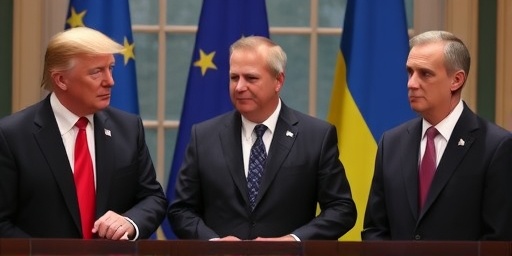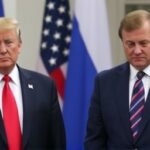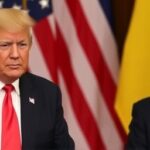In a bold move shaking the foundations of ongoing diplomatic efforts, President Donald Trump has declared that his comprehensive 28-point Ukraine peace plan is far from set in stone, while issuing a stark November 27 deadline for Kyiv to comply with demands that include ceding eastern territories and abandoning aspirations for NATO membership. This revelation, delivered during a high-stakes press conference at the White House, underscores Trump‘s aggressive approach to resolving the protracted conflict with Russia, putting immense pressure on Ukrainian President Volodymyr Zelensky to make concessions or face prolonged warfare.
- Decoding the 28-Point Framework: Territorial Sacrifices and Security Trade-Offs
- Zelensky’s Dilemma: Navigating Domestic Fury and International Isolation
- Russia’s Endgame: Putin’s Leverage in Trump’s Shadow
- NATO’s Fractured Front: Alliance Integrity Under Scrutiny
- Post-Deadline Scenarios: From Ceasefire to Escalated Conflict
Trump‘s statement comes amid escalating tensions in Eastern Europe, where the war has already claimed over 500,000 lives according to recent UN estimates and displaced millions. ‘This is not my final word,’ Trump emphasized, his tone a mix of negotiation and ultimatum. ‘Ukraine has until November 27 to accept these terms, or they can continue to fight. But let’s be clear: time is running out, and the world is watching.’ The proposal, first floated in informal talks last month, outlines a framework that would redraw borders, neutralize Ukraine’s military ambitions, and involve international guarantees to prevent future aggression from Russia.
Decoding the 28-Point Framework: Territorial Sacrifices and Security Trade-Offs
At the heart of Trump’s Ukraine peace plan lies a 28-point blueprint designed to end the bloodshed that began with Russia’s full-scale invasion in February 2022. The document, leaked to major outlets like The New York Times, demands that Ukraine relinquish control over the Donetsk and Luhansk regions—areas partially occupied by Russian forces since 2014 and fully annexed in 2022. In exchange, Trump proposes a demilitarized zone along the new borders, monitored by a coalition of UN peacekeepers and neutral parties such as India and Brazil.
Key provisions include the permanent forfeiture of Crimea, which Russia seized in 2014, and a 15-year moratorium on Ukraine’s pursuit of NATO membership. ‘We’re talking about real peace, not some fairy tale where everyone gets what they want,’ Trump stated. The plan also calls for Ukraine to cap its military spending at 1.5% of GDP, down from the current 5.9%, and dismantle heavy weaponry in the east. Economic incentives are dangled, including $100 billion in U.S.-led reconstruction aid, contingent on compliance.
Experts like Dr. Elena Petrova, a foreign policy analyst at the Brookings Institution, highlight the plan’s audacity. ‘This isn’t just a proposal; it’s a geopolitical reset,’ she told reporters. ‘By forcing Ukraine to surrender land that holds symbolic and strategic value, Trump is essentially validating Russia’s gains while sidelining NATO‘s expansionist policies.’ Statistics from the Kiel Institute for the World Economy show that Western aid to Ukraine has topped $200 billion since 2022, much of it funneled through NATO allies, raising questions about the sustainability of continued support if Trump’s terms are rejected.
Zelensky’s Dilemma: Navigating Domestic Fury and International Isolation
President Zelensky, who has positioned himself as a defiant bulwark against Russian aggression, now faces an existential crossroads. In a televised address from Kyiv hours after Trump’s announcement, Zelensky vowed that Ukraine would never ‘trade its sovereignty for peace at any price.’ Yet, cracks in his resolve are evident. Polls conducted by the Kyiv International Institute of Sociology indicate that 62% of Ukrainians are weary of the war, with support for territorial concessions rising from 28% in 2023 to 45% today amid winter hardships and battlefield stalemates.
Zelensky‘s government has mobilized over 1 million troops, but recent setbacks—like the failed counteroffensive in Kharkiv last summer—have eroded morale. ‘If we accept this, we’re handing Putin a victory on a silver platter,’ said Ukrainian Foreign Minister Dmytro Kuleba in an interview with BBC. Internal dissent is brewing; opposition leaders in parliament are calling for direct talks with Russia, arguing that Trump’s deadline could force a pragmatic pivot. The plan’s NATO clause is particularly galling, as Zelensky has long championed integration with the alliance as a cornerstone of Ukraine’s security architecture.
Behind the scenes, Zelensky is reportedly engaging European leaders. A summit in Brussels next week will see him plead for unified NATO backing, but divisions persist. Germany and France, weary of the economic toll—Europe’s energy prices have surged 300% since the invasion—lean toward negotiation, while Poland and the Baltics remain hawkish.
Russia’s Endgame: Putin’s Leverage in Trump’s Shadow
For Russia, Trump’s intervention is a windfall. President Vladimir Putin, who has framed the war as a defensive stand against NATO encroachment, has already signaled openness to the Ukraine peace plan. In a Kremlin statement, Foreign Minister Sergey Lavrov praised the proposal as ‘a step toward realism,’ noting that it aligns with Moscow’s demands for ‘denazification’ and demilitarization—euphemisms for regime change and neutrality.
Russian state media has amplified Trump’s words, portraying him as a dealmaker restoring balance after years of what they call ‘Western meddling.’ Economically strained by sanctions that have shrunk Russia’s GDP by 2.1% in 2023 per IMF data, Putin sees the November 27 deadline as a chance to lock in gains without further costly advances. Battlefield reports from the Institute for the Study of War indicate Russian forces control about 18% of Ukraine, including key industrial hubs in Donbas.
However, analysts caution that Russia might exploit the deadline for stalling tactics. ‘Putin thrives on ambiguity,’ noted Fiona Hill, former U.S. National Security Council advisor. ‘He’ll likely demand more, like lifting all sanctions, before inking any deal.’ Trump’s rapport with Putin, built during his first term, adds intrigue; whispers of backchannel communications suggest the plan was partly shaped with Moscow’s input.
NATO’s Fractured Front: Alliance Integrity Under Scrutiny
The NATO dimension of Trump’s Ukraine peace plan has ignited fierce debate within the alliance. Founded in 1949 to counter Soviet threats, NATO has expanded eastward post-Cold War, absorbing former Warsaw Pact nations—a move Russia views as existential. Ukraine’s bid for membership, fast-tracked in 2022, symbolized Western commitment, but Trump’s proposal would indefinitely postpone it, potentially unraveling alliance cohesion.
At the recent NATO summit in Washington, Secretary General Jens Stoltenberg reaffirmed support for Kyiv but stopped short of membership guarantees. ‘We stand with Ukraine, but peace must be sustainable,’ he said. Critics like U.S. Senator Lindsey Graham warn that conceding on NATO could embolden adversaries from Beijing to Tehran. Data from the Atlantic Council shows that NATO defense spending hit $1.3 trillion in 2023, with the U.S. footing 68% of the bill—fueling Trump’s frustration over ‘free riders.’
Yet, some allies see opportunity. The UK’s Boris Johnson, in a recent op-ed for The Telegraph, argued that a neutralized Ukraine could stabilize the region, allowing NATO to refocus on cyber and Arctic threats. As the deadline approaches, expect intensified lobbying in Brussels, where Zelensky‘s team is pushing for interim security pacts to fill the NATO void.
Post-Deadline Scenarios: From Ceasefire to Escalated Conflict
As November 27 nears, the world braces for ripple effects. If Ukraine accepts Trump’s terms, it could usher in a fragile peace, with international monitors ensuring compliance and aid flowing to rebuild shattered infrastructure—Ukraine’s reconstruction needs are estimated at $486 billion by the World Bank. A deal might also thaw U.S.-Russia relations, opening doors to broader arms control talks and easing global food prices, which spiked 28% due to Black Sea blockades.
Rejection, however, spells escalation. Trump has hinted at slashing U.S. aid, which totals $61 billion since 2022, forcing Europe to shoulder more. Russia could intensify offensives, targeting Odesa or advancing toward Kyiv, while Zelensky might seek unconventional alliances, perhaps with non-NATO powers like Turkey. Humanitarian costs would soar; the UN reports 10.6 million Ukrainians displaced, with winter looming as a silent killer.
Diplomatic off-ramps exist. Backchannel negotiations in Geneva could refine the 28 points, perhaps softening territorial demands or offering Ukraine economic corridors to the sea. International mediators like the Vatican have offered to host talks, emphasizing that ‘peace is not surrender but survival.’ Ultimately, the deadline tests not just Ukraine’s resilience but the post-Cold War order, with Trump’s gambit potentially reshaping alliances for decades. As Zelensky weighs his next move, the eyes of the free world—and beyond—remain fixed on Kyiv.









